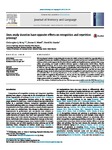Does study duration have opposite effects on recognition and repetition priming?
| dc.contributor.author | Berry, Christopher | |
| dc.contributor.author | Ward, EV | |
| dc.contributor.author | Shanks, DR | |
| dc.date.accessioned | 2017-09-15T13:25:16Z | |
| dc.date.available | 2017-09-15T13:25:16Z | |
| dc.date.issued | 2017-12 | |
| dc.identifier.issn | 0749-596X | |
| dc.identifier.issn | 1096-0821 | |
| dc.identifier.uri | http://hdl.handle.net/10026.1/9932 | |
| dc.description.abstract |
We investigated whether manipulating the duration for which an item is studied has opposite effects on recognition memory and repetition priming, as has been reported by Voss and Gonsalves (2010). Robust evidence of this would support the idea that distinct explicit and implicit memory systems drive recognition and priming, and would constitute evidence against a single-system model (Berry, Shanks, Speekenbrink, & Henson, 2012). Across seven experiments using study durations ranging from 40 ms to 2250 ms, and two different priming tasks (a classification task in Experiments 1a, 2a, 3a, and 4, and a continuous identification with recognition (CID-R) task in Experiments 1b, 2b, and 3b), we found that although a longer study duration improved subsequent recognition in each experiment, there was either no detectable effect on priming (Experiments 1a, 2a, and 4) or a similar effect to that on recognition, albeit smaller in magnitude (Experiments 1b, 2b, 3a, and 3b). Our findings (1) question whether study duration has opposite effects on recognition and priming, and (2) are robustly consistent with a single-system model of recognition and priming. | |
| dc.format.extent | 154-174 | |
| dc.language | en | |
| dc.language.iso | en | |
| dc.publisher | Elsevier BV | |
| dc.subject | Recognition memory | |
| dc.subject | Repetition priming | |
| dc.subject | Study duration | |
| dc.subject | Mathematical model | |
| dc.subject | Signal detection theory | |
| dc.title | Does study duration have opposite effects on recognition and repetition priming? | |
| dc.type | journal-article | |
| dc.type | Journal Article | |
| plymouth.author-url | https://www.webofscience.com/api/gateway?GWVersion=2&SrcApp=PARTNER_APP&SrcAuth=LinksAMR&KeyUT=WOS:000412265500010&DestLinkType=FullRecord&DestApp=ALL_WOS&UsrCustomerID=11bb513d99f797142bcfeffcc58ea008 | |
| plymouth.volume | 97 | |
| plymouth.publication-status | Published | |
| plymouth.journal | Journal of Memory and Language | |
| dc.identifier.doi | 10.1016/j.jml.2017.07.004 | |
| plymouth.organisational-group | /Plymouth | |
| plymouth.organisational-group | /Plymouth/Faculty of Health | |
| plymouth.organisational-group | /Plymouth/Faculty of Health/School of Psychology | |
| plymouth.organisational-group | /Plymouth/REF 2021 Researchers by UoA | |
| plymouth.organisational-group | /Plymouth/REF 2021 Researchers by UoA/UoA04 Psychology, Psychiatry and Neuroscience | |
| plymouth.organisational-group | /Plymouth/Users by role | |
| plymouth.organisational-group | /Plymouth/Users by role/Academics | |
| dcterms.dateAccepted | 2017-07-03 | |
| dc.identifier.eissn | 1096-0821 | |
| dc.rights.embargoperiod | No embargo | |
| rioxxterms.versionofrecord | 10.1016/j.jml.2017.07.004 | |
| rioxxterms.licenseref.uri | http://www.rioxx.net/licenses/all-rights-reserved | |
| rioxxterms.licenseref.startdate | 2017-12 | |
| rioxxterms.type | Journal Article/Review | |
| plymouth.funder | Models of Explicit and Implicit Memory: Linking Priming, Recognition, and Source Memory::ESRC |


